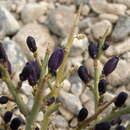en
names in breadcrumbs


Thamnosma montana, the turpentine broom,[1] or Mojave desert-rue, is a shrub in the citrus family Rutaceae. It is native to the deserts of the southwestern United States and northern Mexico. Except immediately after heavy rains, its straight stems usually lack leaves, giving it a broom-like appearance. The Latin specific epithet montana refers to mountains or coming from mountains.[2]
It is a shrub with many straight, broom-like, yellow-green, 30 to 60 centimetres long. Except after heavy rains, it is usually found without leaves.
Stems are speckled with resin glands. Leaves are small and occur only after rains, then fall off (drought deciduous).
Flowers occur at intervals along the stem. Each has a greenish base of blunt sepals. The corolla is oval with rounded ends. The petals royal purple in color. Like most other parts of the plant, petals are studded with visible resin glands. The tips of the petals curve outward, revealing a protruding stigma and shorter yellow-tipped stamens.
The fruit is a leathery, yellow-green, gland-spotted capsule with two nearly separate rounded lobes. Within the capsule are pale, kidney-shaped seeds about 4 millimeters long each. The fruits are eaten by animals which then disperse the seeds.[3]
It grows in dry desert scrub, juniper woodland, and other desert plant communities. It grows among desert plants such as creosote, blackbrush, ephedra, and Yucca species such as Joshua Tree.[3]
Many Native American groups used it as a ceremonial drug, and held beliefs it could be used as a medicine and for pest control.[4]
Thamnosma montana, the turpentine broom, or Mojave desert-rue, is a shrub in the citrus family Rutaceae. It is native to the deserts of the southwestern United States and northern Mexico. Except immediately after heavy rains, its straight stems usually lack leaves, giving it a broom-like appearance. The Latin specific epithet montana refers to mountains or coming from mountains.